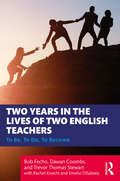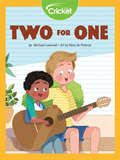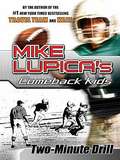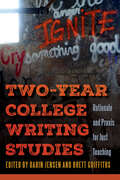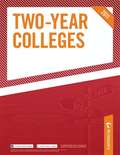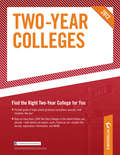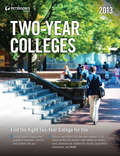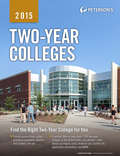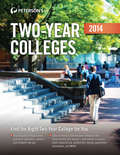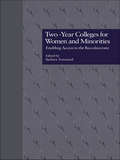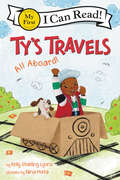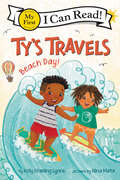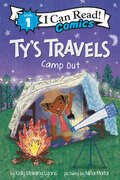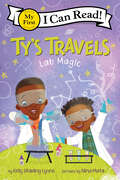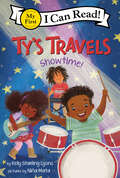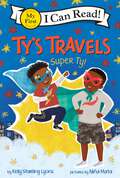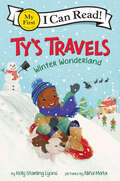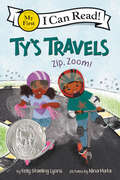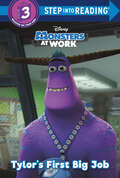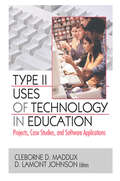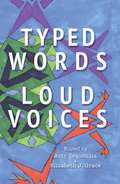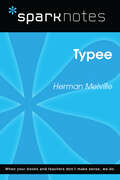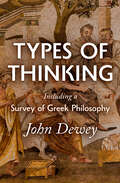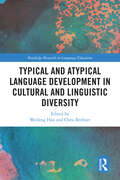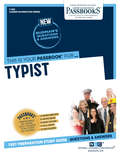- Table View
- List View
Two Years in the Lives of Two English Teachers: To Be, To Do, To Become
by Bob Fecho Dawan Coombs Trevor Thomas Stewart Rachel Knecht Emelio DiSabatoThis book invites readers to explore the complexity of becoming a teacher through the stories of two novice ELA teachers, Emelio and Rachel, over the course of their first two years. The authors’ detailed, empathetic, and ethnographic approach allows space for the teachers to reveal little-seen and often overlooked "wobble moments." These moments illuminate the complexity and nuances that confront, confound, and compel teachers to remain in dialogue with practice. Documenting the journeys of two teachers with compassion and intellectual rigor, this book provides insights into and challenges preconceived notions of what it means to be a teacher. It is essential reading for preservice teachers, scholars, and researchers in English education, as well as individuals considering teaching as a profession.
Two for One
by Michael LeannahPetey has been practicing playing his guitar for the school talent show. He plans to perform a song he wrote himself. One day he hurts his arm and has to wear a cast. How can he play guitar now? A good friend shows him how.
Two-Minute Drill
by Mike LupicaChris Conlan is the coolest kid in sixth grade - the golden-armed quarterback of the football team and the boy all the others look up to. Scott Parry is the new kid, the boy with the huge brain, but with feet that trip over themselves. These two boys may seem like an odd couple, but each has a secret that draws them together, and proves that the will to succeed is even more important than raw talent.
Two-Year College Writing Studies: Rationale and Praxis for Just Teaching
by Darin Jensen Brett GriffithsTwo-Year College Writing Studies is a comprehensive overview of the two-year college writing teaching experience within our current political and historical contexts, with examples for teachers to better enact just teaching practices in their colleges. Editors Darin Jensen and Brett Griffiths present grounded, well-theorized, and practical strategies for teachers to implement in classrooms, institutions, and geopolitical contexts to advocate more effectively for their students. Contributors draw on theories of identity, rhetorical third space, and linguistics to articulate a praxis of just teaching. They describe existing institutional challenges and opportunities that foster equity and offer cautionary tales of educational systems dismantled for short-term economic and political gains. Two-year college writing studies—when properly resourced—holds the potential to foster (or undermine) democratic ideals of civic literacy and uplift. Chapters in this volume offer case study examples of changes in departmental practices for reflection, interaction, and assessment that empower faculty to break free and engage directly with institutional, regional, state, and national constraints. By making these resilient practices visible, Two-Year College Writing Studies amplifies the voices and validates the experiences of instructors engaging in this work. It will serve generalists, specialists, and academics interested in the subdiscipline of student success pedagogies and the political histories of two-year colleges and be useful for instructors new to the field, as professional development for veteran instructors, and as an introduction for graduate students entering two-year college writing studies programs.
Two-Year Colleges 2011
by Peterson’sPeterson's Two-Year Colleges 2011 includes information on nearly 2,000 accredited two-year undergraduate institutions in the United States and Canada, as well as some international schools. It also includes scores of detailed two-page descriptions written by admissions personnel. College-bound students and their parents can research two-year colleges and universities for information on campus setting, enrollment, majors, expenses, student-faculty ratio, application deadline, and contact information. SELLING POINTS: Helpful articles on what you need to know about two-year colleges: advice on transferring and returning to school for adult students; how to survive standardized tests; what international students need to know about admission to U. S. colleges; and how to manage paying for college State-by-state summary table allows comparison of institutions by a variety of characteristics, including enrollment, application requirements, types of financial aid available, and numbers of sports and majors offered Informative data profiles for nearly 2,000 institutions, listed alphabetically by state (and followed by other countries) with facts and figures on majors, academic programs, student life, standardized tests, financial aid, and applying and contact information Exclusive two-page in-depth descriptions written by college administrators for Peterson's Indexes offering valuable information on associate degree programs at two-year colleges and four-year colleges-easy to search alphabetically
Two-Year Colleges 2012
by Peterson'SPeterson's Two-Year Colleges 2012 includes information on more than 1,800 accredited two-year undergraduate institutions in the United States and Canada, as well as some international schools. It also includes detailed two-page descriptions written by admissions personnel. Inside you'll also find: Detailed information on campus setting, enrollment, majors, expenses, student-faculty ratio, application deadline, and contact information. Helpful articles on what you need to know about two-year colleges: advice for adult students on transferring and returning to school ; how to survive standardized tests; what international students need to know about admission to U.S. colleges; how to manage paying for college; and interesting "green" programs at two-year colleges State-by-state summary table allows comparison of institutions by a variety of characteristics, including enrollment, application requirements, types of financial aid available, and numbers of sports and majors offered Informative data profiles for more than 1,800 institutions, listed alphabetically by state (and followed by other countries) with facts and figures on majors, academic programs, student life, standardized tests, financial aid, and applying and contact information Indexes offering valuable information on associate degree programs at two-year colleges and four-year colleges-easy to search alphabetically
Two-Year Colleges 2013
by Peterson'S PublishingPeterson's Two-Year Colleges 2013 includes information on more than 1,800 accredited two-year undergraduate institutions in the United States and Canada, as well as some international schools. <P><P>It also includes detailed two-page descriptions written by admissions personnel. College-bound students and their parents can research two-year colleges, including community colleges, for information on campus setting, enrollment, majors, expenses, student-faculty ratio, application deadline, and contact information. In addition, Two-Year Colleges offers articles that cover tips on transferring, advice for adults returning to school, "green" programs at community colleges, the basics of financial aid, and much more.:<P>Up-to-date, informative data profiles for more than 1,800 institutions, listed alphabetically by state (and followed by other countries) with facts and figures on majors, academic programs, student life, standardized tests, financial aid, and applying and contact information. <P>Helpful articles on what you need to know about two-year colleges: advice on transferring and returning to school for adult students; how to survive standardized tests; what international students need to know about admission to U.S. colleges; and how to manage paying for college. <P>The latest on exciting, innovative "green" programs at community colleges throughout the United States.<P>State-by-state summary table allows comparison of institutions by a variety of characteristics, including enrollment, application requirements, types of financial aid available, and numbers of sports and majors offered.
Two-Year Colleges 2013
by Peterson'sPeterson's Two-Year Colleges 2013 includes information on more than 1,800 accredited two-year undergraduate institutions in the United States and Canada, as well as some international schools. It also includes detailed two-page descriptions written by admissions personnel. College-bound students and their parents can research two-year colleges, including community colleges, for information on campus setting, enrollment, majors, expenses, student-faculty ratio, application deadline, and contact information. In addition, Two-Year Colleges offers articles that cover tips on transferring, advice for adults returning to school, "green" programs at community colleges, the basics of financial aid, and much more.
Two-Year Colleges 2014
by Peterson'S PublishingPeterson's Two-Year Colleges 2014 includes information on more than 1,900 accredited two-year undergraduate institutions in the United States and Canada, as well as some international schools. <P><P>It also includes detailed two-page descriptions written by admissions personnel. College-bound students and their parents can research two-year colleges, including community colleges, for information on campus setting, enrollment, majors, expenses, student-faculty ratio, application deadline, and contact information. In addition, Two-Year Colleges offers articles that cover tips on transferring, advice for adults returning to school, "green" programs at community colleges, the basics of financial aid, and much more. <P>Up-to-date data profiles for more than 1,900 institutions, listed alphabetically by state (and followed by other countries) with facts and figures on majors, academic programs, student life, standardized tests, financial aid, and applying and contact information. <P>Helpful articles on what you need to know about two-year colleges: advice on transferring and returning to school for adult students; how to survive standardized tests; what international students need to know about admission to U.S. colleges; and how to manage paying for college.<P> The latest on exciting, innovative "green" programs at community colleges throughout the United States.<P> State-by-state summary table allows comparison of institutions by a variety of characteristics, including enrollment, application requirements, types of financial aid available, and numbers of sports and majors offered. <P> Exclusive two-page in-depth descriptions written by college administrators for Peterson's. <P> Indexes offering valuable information on associate degree programs at two-year colleges and four-year colleges-easy to search alphabetically.<P>
Two-Year Colleges for Women and Minorities: Enabling Access to the Baccalaureate (RoutledgeFalmer Studies in Higher Education)
by Barbara TownsendTwo-year colleges are often the most financially, geographically, and academically accessible means of higher education for ethnic minorities and women. This book examines five types of two-year special focus schools.
Ty's Travels: All Aboard! (My First I Can Read)
by Kelly Starling LyonsA Geisel Honor-winning series! "Both an excellent book for guided reading and a winning read-aloud." —Kirkus (starred review)Join Ty on his imaginative adventures in Ty's Travels: All Aboard!, a My First I Can Read series by acclaimed author and illustrator team Kelly Starling Lyons and Niña Mata. Family time and imagination and play are highlighted in this fun story, perfect for sharing with children 3 to 6.Ty wishes his family would play with him, but everyone is too busy before dinnertime. Luckily, Ty knows just what to do… Time for fun. Celebrate the power of imagination in All Aboard!With simple, rhythmic text and joyful, bright art, this Guided Reading Level I and My First series is perfect for shared reading with a child. Books at this level feature basic language, word repetition, and whimsical illustrations, ideal for sharing with emergent readers. The active, engaging stories have appealing plots and lovable characters, encouraging children to continue their reading journey.A Chicago Public Library Best Fiction Book for Young Readers 2020 * A 2021 Here Wee Read Ultimate Diverse Children's Book * Author Kelly Starling Lyons selected as the 2021 Piedmont Laureate
Ty's Travels: Beach Day! (My First I Can Read)
by Kelly Starling LyonsA Geisel Honor-winning series * Author Kelly Starling Lyons selected as the 2021 Piedmont Laureate * A Bank Street Best Children's Book of the Year 2022Join Ty on his imaginative adventures in Ty's Travels: Beach Day!, a My First I Can Read book by acclaimed author and illustrator team Kelly Starling Lyons and Niña Mata. Friendship and imagination and play are highlighted in this fun story, perfect for sharing with children 3 to 6.Ty turns an ordinary day in the sandbox into a fun beach day. He wiggles his toes in the sand, finds seashells, builds a castle, and splashes in the ocean. Splish, splash! When his neighbor’s beach ball flies into his backyard, Ty learns that a beach day is even better with a friend.With simple, rhythmic text and joyful, bright art, this My First series and Guided Reading Level I is perfect for shared reading with a child. Books at this level feature basic language, word repetition, and whimsical illustrations, ideal for sharing with emergent readers. The active, engaging stories have appealing plots and lovable characters, encouraging children to continue their reading journey.
Ty's Travels: Camp Out (I Can Read Comics Level 1)
by Kelly Starling LyonsTy makes his I Can Read Comic debut! Featuring a bold comic styling by New York Times bestselling illustrator Niña Mata and a compelling easy-to-read text by Kelly Starling Lyons, this Level One I Can Read Comic is the perfect summertime story for beginning readers! Celebrate Ty’s vivid imagination! Nonstop rain dampens the family’s plans to go camping. But with a boost from Ty, the Camp-Out comes out just fine! Rhythmic text, vibrant art, family love, and Black Boy Joy shine on every page of this camping adventure.Ty’s Travels: Camp-Out is a Level One I Can Read Comic, which means it’s perfect for shared reading with young readers new to graphic novel storytelling. This is a Guided Reading Level (GRL) J.The Ty’s Travels series is much acclaimed-—including a Geisel Honor for Zip, Zoom!
Ty's Travels: Lab Magic (My First I Can Read)
by Kelly Starling Lyons“This installment in the Geisel-winning Ty's Travels series adds some much-needed diversity to the beginning-reader shelf” —Booklist Join Ty on his imaginative adventures in Ty's Travels: Lab Magic, a My First I Can Read book by acclaimed author and illustrator team Kelly Starling Lyons and Niña Mata. Science exploration, imagination, and play are highlighted in this fun story, perfect for sharing with children 3 to 6.Ty and Corey love to visit the museum. When they step through the doors, they become scientists. They study bugs and hunt for fossils. They catch the wind. When Ty can’t participate in a lab activity because of his age, he uses his big imagination at home. Discovering new things is so much fun!Join Ty on his science adventure in this My First I Can Read for beginning readers. With simple, rhythmic text and joyful, bright art, this My First I Can Read book, Guided Reading Level I, is perfect for shared reading with a child. Books at this level feature basic language, word repetition, and whimsical illustrations, ideal for sharing with emergent readers. The active, engaging stories have appealing plots and lovable characters, encouraging children to continue their reading journey.Other acclaim for the Ty's Travels series includes:A Chicago Public Library Best Fiction Book for Young ReadersTy's Travels: All Aboard is a Here Wee Read Ultimate Diverse Children's BookAuthor Kelly Starling Lyons has been selected as the 2021 Piedmont Laureate"Both an excellent book for guided reading and a winning read-aloud." —Kirkus (starred review)
Ty's Travels: Showtime! (My First I Can Read)
by Kelly Starling LyonsTy rocks out with friends in this new book in the Geisel Honor–winning series! Join Ty on his imaginative adventures in Ty's Travels: Showtime, a My First I Can Read story by acclaimed author and illustrator team Kelly Starling Lyons and Niña Mata. Music, imagination, and play are highlighted, making this perfect for sharing with children ages 3 to 6.Rap-a-tap-tap!Thrum, thrum, thrum!Plink-a-plink-plink!Ty loves playing the instruments, but something’s missing—his friends! With the help of his vivid imagination, Ty and his friends are onstage in a band making great music together.With simple, rhythmic text and joyful, bright art, this My First series is perfect for shared reading with a child. Books at this level feature basic language, word repetition, and whimsical illustrations, ideal for sharing with emergent readers. The active, engaging stories have appealing plots and lovable characters, encouraging children to continue their reading journey.Praise for Ty's Travels series:Ty’s Travels: All Aboard has been named United Through Reading's 2024 Book for the Military Child.
Ty's Travels: Super Ty! (My First I Can Read)
by Kelly Starling LyonsTy soars as a superhero in this new book in the Geisel Honor–winning series!Join Ty on his fun adventures in Ty’s Travels: Super Ty!, a My First I Can Read book by acclaimed author and illustrator team Kelly Starling Lyons and Niña Mata. Imagination, helpfulness, and play are highlighted, making this book perfect for sharing with emerging readers!Ty loves superheroes. He watches them on TV and reads books about them.When he puts on a cape and a mask, he becomes Super Ty! Super Ty flies around helping Momma and others. But even with his super skills, he can't solve every problem by himself. That’s what Ty’s super friends are for—like his brother!With simple, rhythmic text and joyful, bright art, this My First series is perfect for shared reading with a child. Books at this level feature basic language, word repetition, and whimsical illustrations, ideal for sharing with emergent readers. The active, engaging stories have appealing plots and lovable characters, encouraging children to continue their reading journey.Don’t miss these other books in the series:· Ty's Travels: Showtime!· Ty's Travels: Camp-Out· Ty's Travels: Lab Magic· Ty's Travels: Winter Wonderland· Ty's Travels: Beach Day!· Ty's Travels: Zip, Zoom!· Ty’s Travels: A 5-Book Reading Collection
Ty's Travels: Winter Wonderland (My First I Can Read)
by Kelly Starling LyonsA Geisel Honor-winning series! Author Kelly Starling Lyons selected as the 2021 Piedmont Laureate! Join Ty on his imaginative adventures in Ty's Travels: Winter Wonderland, a My First I Can Read book by acclaimed author and illustrator team Kelly Starling Lyons and Nina Mata. Imagination and play are highlighted in this festive Winter story, perfect for sharing with children 3 to 6.Ty’s big imagination takes him and Momma on a trip to the North Pole. Everything is wonderful! A Christmas tree sparkles, a snowman waves, and a polar bear sings. Will Ty’s wish to see Santa come true? He wishes and wishes. Ty's Travels: Winter Wonderland fills an important need for inclusive Christmas stories with diverse characters.With simple, rhythmic text and joyful, bright art, this My First series and Guided Reading Level I is perfect for shared reading with a child. Books at this level feature basic language, word repetition, and whimsical illustrations, ideal for sharing with emergent readers. The active, engaging stories have appealing plots and lovable characters, encouraging children to continue their reading journey."A cozy, snowy Christmastime read." —Kirkus
Ty's Travels: Zip, Zoom! (My First I Can Read)
by Kelly Starling LyonsTy can’t wait to ride his brand-new scooter at the park. Other kids zip and zoom by like race cars, but all Ty can do is wobble! Ty wants to give up, but a new friend helps Ty give it another try. <p><p>A 2021 Geisel Honor Book!Celebrate imagination and the power of persistence in Ty's Travels: Zip, Zoom! by the acclaimed author and illustrator team Kelly Starling Lyons and Niña Mata. With simple, rhythmic text and joyful, bright art, this Guided Reading Level I and My First series I Can Read is perfect for shared reading with a child. Books at this level feature basic language, word repetition, and whimsical illustrations, ideal for sharing with emergent readers. The active, engaging stories have appealing plots and lovable characters, encouraging children to continue their reading journey. <P><P><i>Advisory: Bookshare has learned that this book offers only partial accessibility. We have kept it in the collection because it is useful for some of our members. Benetech is actively working on projects to improve accessibility issues such as these.</i>
Tylor's First Big Job (Step into Reading)
by RH DisneyA step 3 levelled reader based on the Disney+ show Monsters at Work!Inspired by Disney and Pixar&’s hit film Monsters, Inc. the Disney+ animated show Monsters at Work follows Tylor Tuskmon, an enthusiastic member of the Monsters, Inc. Facilities Team (MIFT) who dreams of following in the footsteps of his idols—Mike and Sulley—and making his way up to the Monsters, Inc. Laugh Floor as a Jokester. Girls and boys ages 5 to 7 will love this Step 3 Step into Reading leveled reader based on an episode of the show. Step 3 readers feature engaging characters in easy-to-follow plots about popular topics. For children who are ready to read on their own
Type II Uses of Technology in Education: Projects, Case Studies, and Software Applications
by Cleborne D. Maddux D. LaMont JohnsonSpark your students to actually want to learn through the creative application of technology!Type II applications in education make it possible to teach in new and more effective ways. Type II Uses of Technology in Education: Projects, Case Studies, and Software Applications clearly explains methods and strategies presently used by teachers to offer students a creative learning experience through the application of technology. Each chapter presents individual examples of how teachers have applied technology in schools and classrooms, illustrating through case studies, projects, and software applications how to effectively spark students&’ interest and learning. Type II Uses of Technology in Education is the third in a series (Internet Applications of Type II Uses of Technology in Education and Classroom Integration of Type II Uses of Technology in Education, both from Haworth) that provides a clear view of the advantages-and challenges-involved in the use of technology to enhance and actively involve students in the learning process. The applications described and discussed at length here go beyond the mundane educational functions like grading or presenting drill and practice exercises to explore fresh ways of teaching and learning. Students can become involved and actually want to learn, all through the use of creative technology application. The book also includes tables and figures to enhance understanding of the material.Type II Uses of Technology in Education discusses: data collection, analysis, and communication in student research using pocket PCs and laptops the educational effect of using a learning object as a pedagogical model rather than simply being technological in nature examples of integrated Type II activities e-learning courses using interactive video, WebCT, and on-site discussion groups electronic discussion applications in a laptop university teacher education program challenges facing students using computers to enhance and express the extent of their learning information and communication technology (ICT) integration into schools-using three illustrative case studies forward planning needed to make the difficult change to technological application for learning a case study that used problem-based learning software with at-risk students using technology to reinforce visual learning strategies digital portfolio development as a Type II application interactive computer technology in art instruction on-demand help features for effective interactive learning experience Personal Educational Tools (PETs) Type II Uses of Technology in Education: Projects, Case Studies, and Software Applications provides numerous illustrations of technology learning in action and is perfect for educators and students in programs dealing with information technology in education, and for public school personnel with interests and responsibilities in using information technology in the classroom.
Typed Words, Loud Voices
by Various"I'd like coffee, please." "No. I don't believe you. How do I know it is really you who wants coffee and not your friend there subliminally transmitting that to you by touching your shoulder?" Imagine a world where you had to prove you knew your own mind even to get a cup of coffee, where it was generally assumed that you could have no thoughts of your own, so if you did express your thoughts, it must be some trick. What would you do? Would you give up, or demand to be heard? Sadly, this world is not imaginary for many of the writers in this book, who have chosen the path of demanding to be heard. Their best (and sometimes only) mode of communication is sometimes called "discredited" because it was "tested" in ways that make no sense. <p><p> Typed Words, Loud Voices is written by a coalition of writers who type to talk and believe it is neither logical nor fair that some people should be expected to prove themselves every time they have something to say. Read our arguments and hear us. Help us change the world.
Typee (SparkNotes Literature Guide Series)
by SparkNotesTypee (SparkNotes Literature Guide) by Herman Melville Making the reading experience fun! Created by Harvard students for students everywhere, SparkNotes is a new breed of study guide: smarter, better, faster. Geared to what today's students need to know, SparkNotes provides: *Chapter-by-chapter analysis *Explanations of key themes, motifs, and symbols *A review quiz and essay topicsLively and accessible, these guides are perfect for late-night studying and writing papers
Types of Thinking Including a Survey of Greek Philosophy
by John DeweyA lost series of lectures on the history of philosophy, first delivered in China, now available in English for the first time.This volume reconstructs a series of lectures delivered by John Dewey during his historic trip to China. Though Dewey&’s original notes were lost, Prof. Robert W. Clopton and Dr. Tsuin-Chen Ou were able to translate his works as they appeared in Chinese newspapers.Beyond their historical significance, these lectures show Dewey at the height of his power, discussing and criticizing various schools of philosophy. This includes a brief but comprehensive account of Greek philosophy from the pre-Socratics through Aristotle. Dewey also discusses his own experimental thinking, presenting his position in systematic form for the first time. &“The most complete presentation of Dewey&’s theory of the development of philosophy, in prose simpler and clearer than he himself ever provided . . . Types of Thinking deserves a place in every subject collection.&” —Library Journal
Typical and Atypical Language Development in Cultural and Linguistic Diversity (Routledge Research in Language Education)
by Weifeng Han and Chris BrebnerTypical and Atypical Language Development in Cultural and Linguistic Diversity brings together state-of-the-art studies in both typical and atypical language development. Placing the topic in the context of cultural and linguistic diversity (CALD), the book offers readers serious theoretical consideration of the topic and provides implications for multilingual educational and clinical practices. The content covers a wide range of topics related to multilingual language development in CALD: typical and atypical language development in CALD, and the interface between both; the relationship between multilingual competence and academic performance in CALD; providing unbiased speech and language measures in CALD; and heritage and minority languages education in CALD. Each chapter outlines the core theoretical and practical issues and explores both theoretical and pedagogical/clinical implications in the area and possible future developments. This volume is an essential resource for all those who study, research, or are interested in multilingual development, educational linguistics, and clinical linguistics in the CALD context.
Typist: Passbooks Study Guide (Career Examination Series #C-3373)
by National Learning CorporationThe Typist Passbook® prepares you for your test by allowing you to take practice exams in the subjects you need to study. It provides hundreds of questions and answers in the areas that will likely be covered on your upcoming exam, including but not limited to: spelling; English grammar and usage, punctuation; office record keeping; clerical abilities; alphabetizing; and more.
